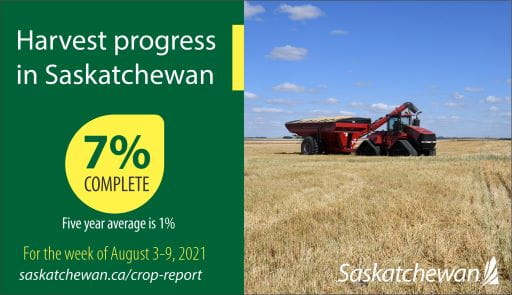Released on August 12, 2021
Warm weather has continued to help crops mature throughout the province. Producers have been able to make considerable headway with harvest; seven per cent of crop is now combined and six per cent is ready to straight combine. The five-year average (2016-2020) for this time of year is one per cent combined and two per cent ready to straight-combine. Scattered showers throughout the province have caused short delays to harvest but producers are happy to finally receive rain.
Fifty-four per cent of winter wheat, 51 per cent of fall rye, 37 per cent of field peas and 29 per cent of lentils are now in the bin.
Harvest is most advanced in the south and west-central regions, where 12 per cent of crop in the southwest, eight per cent of crop in the southeast and seven per cent of crop in the west-central is combined. Producers in the northern regions have a little more than one per cent of crop combined.
Much of the province received small amounts of rain this week, with parts of the northern, west-central and southeast regions receiving half an inch to an inch. The Lipton area received the most rainfall this week with 37 mm. The Langenburg area received 27 mm, the Rhein area 32 mm and the Indian Head area received 24 mm. More rain would be welcomed to help late seeded crops fill the last of their seed. The biggest benefit of the rain will be to pasture land that has struggled to endure the drought.
Small showers during the week did little to offset the ongoing drought but there was a slight increase in topsoil moisture conditions. Cropland topsoil moisture is rated as six per cent adequate, 32 per cent short and 62 per cent very short. Hay and pasture land topsoil moisture is rated as five per cent adequate, 28 per cent short and 67 per cent very short.
Many producers have noted that hay yields are below average this year. Estimated average dryland hay yields for the province are 0.80 tons per acre for alfalfa, 0.70 tons per acre for alfalfa/bromegrass, 0.60 tons per acre for other tame hay, 0.60 tons per acre for wild hay and 1.0 tons per acre for greenfeed. Estimated average irrigated hay yields are 1.3 tons per acre for alfalfa, 1.80 tons per acre for alfalfa/bromegrass and 2.2 tons per acre for greenfeed.
The majority of crop damage this week was due to wind, drought stress, heat, wildlife, grasshoppers and flea beetles. There have also been isolated reports of hail.

Producers are busy wrapping up haying and baling, getting ready for harvest, desiccating and swathing crops and combining in some areas.
On Aug. 10, Agriculture Minister David Marit announced $119 million in provincial support under AgriRecovery, with the federal government requested to provide its full 60 per cent cost-share to increase the total program value to $297 million. The program will provide a per head payment to help maintain female breeding stock. The province is currently working with the federal government to finalize the details of the program which will be administered by Saskatchewan Crop Insurance Corporation; this information, including how to apply, will be shared as soon as possible.
Producers are reminded that in response to the feed shortage this year, Saskatchewan Crop Insurance Corporation is doubling the Low Yield Appraisal threshold values for customers who salvage their cereal or pulse crops as feed, without negatively impacting future individual coverage. Customers are asked to contact their local SCIC office before they graze, bale or silage any damaged crops to discuss their options. Additionally, the Government of Saskatchewan made changes to temporarily increase the maximum funding a livestock producer can receive from the Farm and Ranch Water Infrastructure Program (FRWIP) for dugouts, wells and pipelines for agricultural use.
The federal and provincial governments have also increased the 2021 AgriStability interim benefit payment percentage from 50 per cent to 75 per cent for Saskatchewan producers. The interim benefit provides the opportunity for producers who are enrolled in AgriStability to access a portion of their benefit early, to help support losses and cover costs. To apply for an interim benefit, producers can contact their local SCIC office, call the AgriStability Call Centre toll-free at 1-886-270-8450, or email agristability@scic.ca.
Producers are also reminded the Farm Stress Line is available for support 24-hours-a-day, seven-days-a-week, toll-free at 1-800-667-4442. Calls are answered by Mobile Crisis Services Regina, a non-profit, community-based agency, and there is no call display.
A complete, printable version of the Crop Report is available online at https://www.saskatchewan.ca/crop-report.
Follow the 2021 Crop Report on Twitter at @SKAgriculture.
-30-
For more information, contact:
Matt Struthers
Agriculture
Moose Jaw
Phone: 306-694-3714
Email: matt.struthers@gov.sk.ca
Cell: 306-630-8865

